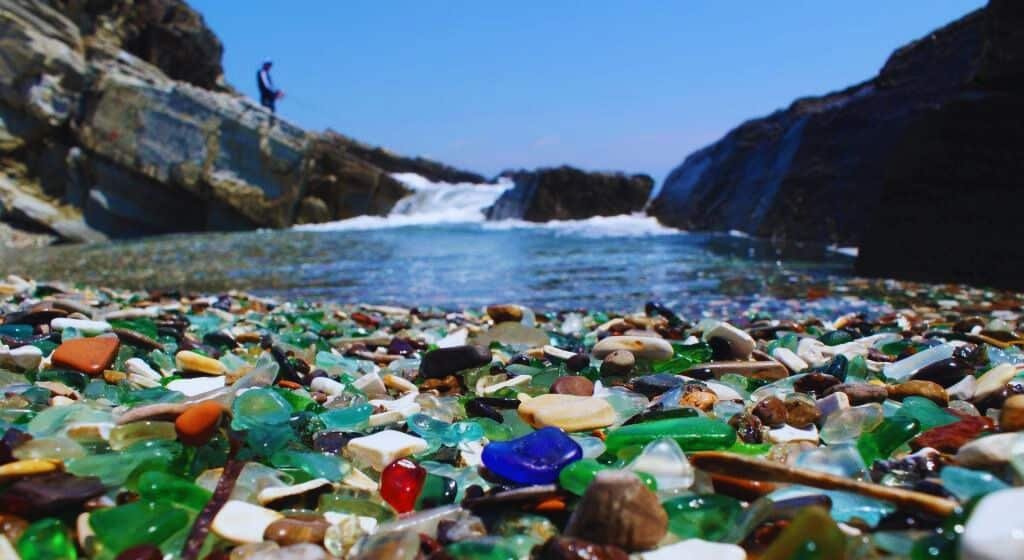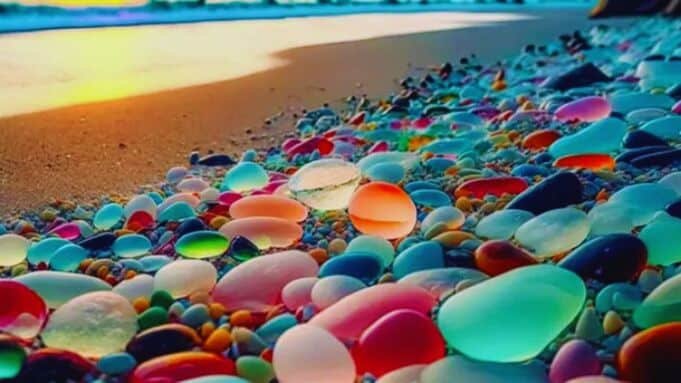Nestled along the rugged coastline of Northern California lies a treasure trove like no other. Imagine a beach sparkling with countless hues, where the waves of the Pacific Ocean have worked their magic to transform human-made debris into nature’s colorful gems.
Welcome to Glass Beach California, where vibrant sea glass pebbles dot the shoreline, offering a unique glimpse into the past and a striking reminder of the environment’s resilience.
Once a dumpsite, this unique stretch of coastline near Fort Bragg has become an iconic symbol of transformation. In this article, we’ll delve into the fascinating history of Glass Beach California, explore its natural beauty, and examine the efforts to preserve this magical place for future generations.
How was Glass Beach California Formed?
Northern California is an ideal destination for those seeking a serene escape into nature. You can savor exquisite California wine, explore captivating museums, and stroll along some of Mendocino’s most stunning beaches. For those willing to venture a bit further north, Glass Beach in Fort Bragg awaits, just 15 minutes from Sea Rock Inn. It’s a mesmerizing sight for visitors looking to be awed.
While it may appear magical today, the history of Glass Beach is far less glamorous. Over a century ago, the beach served as a dumpsite, with various glass containers of all shapes and sizes discarded over the cliffs and into the ocean. This practice began in 1906 and continued for many years.
Fortunately, the story has a happy ending. In 1967, rising environmental concerns put an end to the dumping. Instead of polluting the area, the discarded glass was broken up and churned by the ocean, creating the smooth, colorful treasures that now adorn the shoreline.
Related: El Salvador Beaches
The Fascinating History of Glass Beach California
Glass Beach, once a dump site in the early 1900s, transformed into a colorful treasure trove as ocean waves polished discarded glass into smooth, vibrant sea glass gems.
Early 20th Century: Origins of the Beach
In the early 1900s, the booming logging town of Fort Bragg needed a convenient location to dispose of its growing waste. Thus, the nearby coastline, known today as Glass Beach, became a dumpsite for everything from household garbage to discarded appliances and automobiles. Locals referred to it simply as “The Dumps,” and it remained a receptacle for the town’s trash until the mid-20th century.
The Cleanup Efforts
By the 1960s, changing attitudes toward environmental conservation led to the closure of the dumpsite. In the following decades, efforts to clean up the area were launched, and the beach was eventually incorporated into the MacKerricher State Park system. While the bulk of the larger debris was removed, millions of glass shards remained, slowly being ground down by the relentless ocean waves.
Nature’s Artistry
Over the years, the combination of waves, sand, and time transformed the remaining glass debris into smooth, colorful pebbles known as sea glass. The ocean polished the jagged edges into round and frosted pieces that now shimmer in shades of blue, green, amber, and red across the beach.
The frosted glass pebbles tell stories of discarded bottles, pottery, and other relics of the past century. Their smooth, tactile shapes have captured the imagination of visitors worldwide, turning a once-forgotten dumpsite into a beloved natural wonder.
Related Read: Best Destin Florida Beaches
California Beaches Where You Can Find Sea Glass

Finding sea glass, those colorful bits of glass naturally polished by ocean waves, is one of the greatest joys of beachcombing. Much like seashells, sand dollars, agates, and driftwood, sea glass is a stunning treasure.
Knowing when and where to search is essential. In addition to exploring the main beach areas, especially pebble-covered shores, try looking in the crevices of fixed rocks, creek beds, and at the far ends of the beach. Often, sea glass can be found in the surf being rolled by the waves, but exercise caution near the water. Low tide is generally the best time to search (consult tide tables).
If you find sea glass, it’s best to leave it on the beach and capture photos instead. If you choose to take a piece, limit yourself to just one. Be aware that it’s illegal to collect sea glass where signage prohibits it.
Experiencing the Beauty of Glass Beach California
Glass Beach dazzles visitors with its shimmering sea glass-covered shores, a testament to nature’s ability to transform past environmental mistakes into a stunning, colorful coastline worth exploring.
Visiting Glass Beach
Located near the town of Fort Bragg, Glass Beach is easily accessible by car via Highway 1. Travelers can follow signs to MacKerricher State Park and park at the designated lot. A short walk will lead you to the shoreline, where you can explore the colorful treasures scattered along the sand.
Best Times to Visit in Glass Beach California:
- Spring and Summer: Mild temperatures, abundant wildflowers, and calmer waves make these seasons ideal for visiting.
- Morning or Evening: Visiting during low tide allows for the best sea glass hunting and tidepool exploration.
What to Bring:
- Comfortable walking shoes
- Sun protection (hat, sunscreen)
- Reusable water bottles and snacks
- Camera to capture the stunning scenery
READ: Explore Davao Beach
What to See and Do in Glass Beach California?
At Glass Beach California, discover vibrant sea glass treasures, explore fascinating tide pools teeming with marine life, and enjoy scenic coastal views within the MacKerricher State Park.
Sea Glass Treasures:
The main attraction of Glass Beach is the sea glass itself. Visitors can marvel at the colorful pebbles and observe how different shades and sizes reflect the ocean’s artistic touch.
Tidepooling:
Explore the nearby tide pools for a glimpse of the region’s vibrant marine life, including sea anemones, starfish, and crabs. It’s a great activity for families and nature enthusiasts alike.
Nearby Attractions:
- Skunk Train: Take a ride on this historic steam-powered train through the towering redwoods of Mendocino County.
- MacKerricher State Park: Enjoy hiking, birdwatching, and whale-watching in this beautiful coastal park.
- Noyo Harbor: Savor fresh seafood at the local restaurants or take a scenic boat tour from this bustling harbor.
READ: Best Nude Beaches in Florida
Environmental Impact and Preservation
The rising popularity of Glass Beach has led to a sea glass shortage, prompting strict collection regulations and conservation initiatives to preserve this unique coastal gem for future generations.
The Sea Glass Shortage
As Glass Beach’s popularity has grown, so too has the desire to collect its colorful treasures. Unfortunately, this has led to a notable decline in the sea glass supply, leaving fewer pebbles to adorn the shoreline. In response, local authorities have implemented strict regulations against removing sea glass, emphasizing the importance of preservation.
Local Conservation Efforts
Community groups and the California State Parks system are working together to protect and restore Glass Beach. Initiatives include regular cleanups, educational programs on responsible tourism, and the enforcement of collection restrictions.
Visitors can contribute to these efforts by:
- Volunteering for local beach cleanups
- Donating to conservation organizations supporting Glass Beach
- Respecting the site’s rules and encouraging others to do the same
The Legacy of Glass Beach
Glass Beach stands as a testament to both humanity’s impact on the environment and nature’s incredible ability to heal. What was once an eyesore of garbage has become a stunning natural wonder, inspiring visitors to reflect on the importance of environmental conservation.
By understanding its history and taking part in its preservation, visitors can ensure that Glass Beach remains a colorful gem for future generations.
Conclusion
Glass Beach, with its shimmering sea glass treasures, offers a unique and mesmerizing blend of history and natural beauty. From its origins as a dumpsite to its current status as a must-visit destination, this vibrant coastline is a symbol of transformation and resilience.
As we look to the future, the preservation of Glass Beach hinges on responsible tourism and community efforts. So, whether you’re planning a visit or simply marveling from afar, remember to cherish and protect this one-of-a-kind gem.
Read More: Best Clear Water Beaches in Florida
Frequently Asked Questions (FAQs) About Glass Beach California
Here you can find a few commonly asked questions about Glass Beach California. Let’s check them out.
What is Glass Beach, and where is it located?
Glass Beach is a unique coastal area known for its colorful sea glass pebbles, located near Fort Bragg in Northern California within MacKerricher State Park.
How did Glass Beach get its sea glass?
The sea glass formed from discarded glass bottles and other waste that were dumped on the beach in the early 20th century. Over time, the ocean smoothed and polished these glass fragments.
Can visitors collect sea glass from Glass Beach?
No, it is illegal to collect sea glass from Glass Beach to preserve the natural beauty and supply for future visitors. Instead, visitors are encouraged to take photos.
What is the best time to visit Glass Beach?
The best time to visit is during low tide when more sea glass is exposed. Spring and summer offer mild temperatures and calmer waves.
Are there other attractions near Glass Beach?
Yes, nearby attractions include the Skunk Train, Noyo Harbor, and MacKerricher State Park, offering activities like hiking, whale watching, and scenic train rides.
How do I get to Glass Beach?
Glass Beach is accessible via Highway 1 near Fort Bragg. Visitors can park at the designated lot in MacKerricher State Park and take a short walk to the beach.
How can I help preserve Glass Beach?
Visitors can help by following the “leave no trace” principles, avoiding glass collection, and supporting local conservation efforts through donations or volunteering for beach cleanups.















